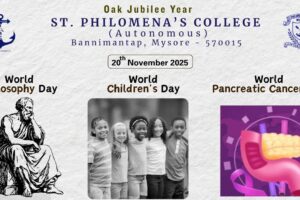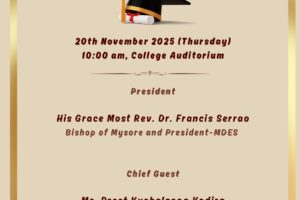
Extension activity

Time: 2:00- 4:30 pm
Venue: Government lower primary school Belvatta Grama
No. of participants: 1st year and 2nd year students of B.Sc Biotechnology
Place of Activity: Belvatta Grama Mysuru
Objective of the activity:
- The aim of this activity is to get the student a better perspective of the learning aids through science
- Develop inquiring minds and curiosity about science and the natural world.
- develop skills of scientific inquiry to design and carry out scientific investigations and evaluate scientific evidence to draw conclusions
Communicate scientific ideas, arguments and practical experiences accurately in a variety of ways
- Appreciate the benefits and limitations of science and its application in technological developments
Outcome of the activity:
- To enabling students to understand the interdependence between science and society.
- Students should be aware of the global dimension of science, as a universal activity with consequences for our lives and subject to social, economic, political, environmental, cultural and ethical factors.
- describe and evaluate the benefits and limitations of science and scientific applications as well as their effect on life and society
- Use where appropriate a range of information and communication technology applications to access, process and communicate scientific information.
Summary of Activity:
The Extension activity was organized by the department of biotechnology at Government lower primary school belvatta grama mysuru which was held on 6th july2022 between 2:00 pm to 4:30pm.Students of under graduate level enthusiastically conducted the activities for the students of class 1 to Class 5 under the supervision of the faculty members confining safety and imparting knowledge through conducting experiments in science which were prescribed in their curriculum of class 1 to 5
The following experiments were conducted:
- VISCOSITY
A fluid with large viscosity resists motion because its strong intermolecular forces give it a lot of internal friction, resisting the movement of layers past one another. On the contrary, a fluid with low viscosity flows easily because its molecular makeup results in very little friction when it is in motion. Gases also exhibit viscosity, but it is harder to notice in ordinary circumstances.
- EGG IN VINEGAR -BOUNCY
Eggshells are made of calcium carbonate , soak an egg in vinegar the eggshell absorb the acid and break down, or dissolve. The calcium carbonate converts to carbon dioxide gas, which causes air bubble.hence egg floats in the vinegar
Adding salt to the water increases the density of the solution because the salt increases the mass without changing the volume very much. When enough salt is added to the water, the saltwater solution’s density becomes higher than the egg’s, so the egg will then float.
- AIR PRESSURE : he water in the bottle has air pressure pushing down on it. When the balloon is released, the air pressure on top of the water increases. This increased pressure forces the water out of the straw and creates the balloon powered water fountain. This is because the high pressure air in the balloon pushes outward harder than the low pressure air in the bottle. The air in the balloon pushes out against the walls, keeping it inflated. When the hole is unplugged, air flows back into the bottle. The air pressure in the bottle increases and collapses the balloon.
- MICROBES: An agar plate is a thin layer of nutrient gel in a Petri dish, used to grow bacteria and fungi in the microbiology laboratory. polysaccharide derived from the cell walls of red seaweed. A variety of nutrients can be added to the agar to preferentially grow different bacteria Microbes that are suspended in air are also called bioaerosols these microbes were trapped and shown on a agar plate .
- :A candle’s wax molecules are made primarily of carbon and hydrogen. As the wax burns, it reacts with oxygen in the air. In this experiment, the candle’s flame went out when it used up all the oxygen in the jar. A burning reaction is called combustion.



- MAGIC INK : Lemon juice contains carbon compounds that are colorless at room temperature. The heat from the light bulb breaks down the compounds and releases the carbon. The carbon oxidises when it comes into contact with the air and turns brown, making your invisible message visible under the hot light bulb.
Students of the school were interested and actively took part in the experiment along with graduate class it was a complete task of experiment and discussion which went hand in hand .We were contented to share the knowledge with the budding stars of future and provided an idea about scientific thinking and reasoning.
Organised by
Coordinator: Ms. Naziya Habeeb M Convenor: Ms Milagris Antonius
HOD &Assistant Professor Assistant Professor
Department of biotechnology Department of biotechnology



